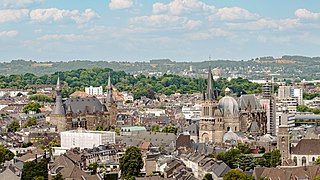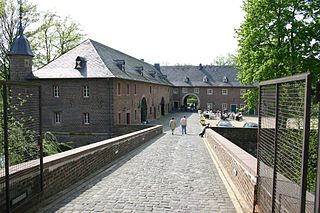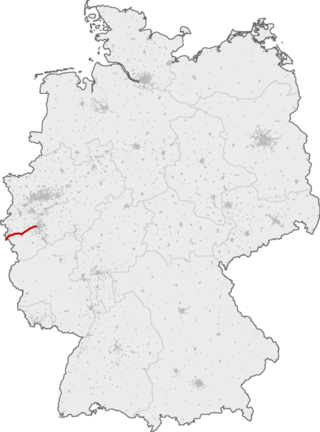
Aachen is the 13th-largest city in North Rhine-Westphalia and the 27th-largest city of Germany, with around 252,000 inhabitants.

Düren is a town in North Rhine-Westphalia, Germany, between Aachen and Cologne, on the river Rur.

The Cologne–Aachen high-speed line is the German part of the Trans-European transport networks project high-speed line Paris–Brussels–Cologne. It is not a newly built railway line, but a project to upgrade the existing railway line which was opened in 1841 by the Rhenish Railway Company. When it was continued into Belgium in 1843, it became the world's first international railway line.

The 2003 Alabama earthquake took place on April 29 at 3:59 A.M. Central Daylight Time eight miles (13 km) east-northeast of Fort Payne, Alabama. The number of people who felt this quake was exceptionally high as the earthquake could be felt in 11 states across the East Coast and as far north as southern Indiana. The earthquake was strongly felt throughout metropolitan Atlanta. The Georgia Building Authority was called out to inspect the historic Georgia State Capitol in downtown Atlanta and other state-owned buildings but found no problems. However, this is not out of the ordinary as earthquakes east of the Rocky Mountains can be felt several times the area felt on West Coast earthquakes. The earthquake was given a magnitude 4.6 on the moment magnitude scale by the USGS and reports of the duration of the shaking range from 10 seconds to as long as 45 seconds. It is tied with a 1973 earthquake near Knoxville, Tennessee as the strongest earthquake ever to occur in the Eastern Tennessee Seismic Zone, which is the second most active seismic zone east of the Rocky Mountains, with the New Madrid Seismic Zone the most active.

The 1356 Basel earthquake is the most significant seismological event to have occurred in Central Europe in recorded history and had a moment magnitude in the range of 6.0–7.1. This earthquake, which occurred on 18 October 1356, is also known as the Sankt-Lukas-Tag Erdbeben, as 18 October is the feast day of Saint Luke the Evangelist.

Neuss Central Station is the railway station for the city of Neuss in the German state of North Rhine-Westphalia. The main station building is built on a platform between the tracks and it is located at the junction of the Lower Left Rhine Railway and the Mönchengladbach–Düsseldorf railway. These lines also connect with the Düren–Neuss railway and the Neuss–Viersen railway; the latter has ended since 1984 at Kaarster See station and is operated by the private Regiobahn company.

The Wabash Valley Seismic Zone is a tectonic region located in the Midwestern United States, centered on the valley of the Lower Wabash River, along the state line between southeastern Illinois and southwestern Indiana.

Düren station is located to the north of the centre of Düren and is the largest station in the city and the district of Düren. It is located at the intersection of the Cologne–Aachen high-speed line with the lines to Linnich, Heimbach and Euskirchen. Until 1992 it was also connected to the Erft Railway.

Horrem station is a station in the Kerpen district of Horrem in the German state of North Rhine-Westphalia. It is a railway junction of the Cologne–Aachen high-speed railway and the Erft Railway. The triangular station of Horrem is served by regional services and by S-Bahn trains of the Rhine-Ruhr S-Bahn. Long-distance trains run through on the high-speed line without stopping. It is classified by Deutsche Bahn as a category 3 station.

Frechen-Königsdorf station is a station in the village of Königsdorf in the German state of North Rhine-Westphalia on the Cologne–Aachen high-speed railway.

Sindorf station is a train station in the town of Sindorf in the German state of North Rhine-Westphalia on the Cologne–Aachen high-speed railway. The station is in the south-east of the Kerpen district of Sindorf and has a side platform on the south side of the S-Bahn line. This is bounded to the south by a noise barrier and the entrances and exits are at the ends of the platform.
The 1992 Roermond earthquake occurred on 13 April, around 3:20 AM with a moment magnitude of 5.3 and a maximum Mercalli intensity of VIII (Severe). Striking on the Peel Boundary Fault, a normal fault near Roermond, it was the strongest recorded earthquake in the Netherlands and in Northwestern Europe, and caused substantial damage to older buildings in the Netherlands and adjacent countries of Belgium and Germany. A series of aftershocks followed.

The Oklahoma earthquake swarms are an ongoing series of human activity-induced earthquakes affecting central Oklahoma, southern Kansas, northern Texas since 2009. Beginning in 2009, the frequency of earthquakes in the U.S. state of Oklahoma rapidly increased from an average of fewer than two 3.0+ magnitude earthquakes per year since 1978 to hundreds each year in the 2014–17 period. Thousands of earthquakes have occurred in Oklahoma and surrounding areas in southern Kansas and North Texas since 2009. Scientific studies attribute the rise in earthquakes to the disposal of wastewater produced during oil extraction that has been injected more deeply into the ground.

A series of major earthquakes struck Central Italy between the Marche and Umbria regions in October 2016. The third quake on 30 October was the largest in Italy in 36 years, since the 1980 Irpinia earthquake.

The Insheim Geothermal Power Station is a geothermal power station in Rhineland-Palatinate.
The 1756 Düren earthquake occurred on the morning at 8 a.m. near the town of Düren with a magnitude of 6.4 on the Richter scale. It was one of the strongest earthquakes in Central Europe, and the strongest in Germany's recorded history. The depth of the hypocenter is estimated at 14–16 kilometres (8.7–9.9 mi). This earthquake may have been a remotely triggered event from the 1755 earthquake in Lisbon, but there is not enough evidence for this.
The 1692 Verviers earthquake, also known as the 1692 Ardennes earthquake, occurred in the east of Belgium on 18 September 1692 measuring around 6.2 on the Richter scale. Parish records and historical accounts strongly indicate the earthquake's epicenter was northwest of Verviers, and the event was widely felt across Western Europe in modern-day Belgium, England, Germany, the Netherlands, Luxembourg, and France. The largest amount of damage occurred in the northwestern environs of Verviers, then part of the Prince-Bishopric of Liège. Researchers at the Royal Observatory of Belgium have considered this the strongest known earthquake in Western Europe north of the Alps, which occurred as part of a sequence of quakes from the Lower Rhine Graben in September 1692.

The Jewish Cemetery Aachen is located in Aachen in North Rhine-Westphalia. It is on the corner of Lütticher Straße and Körnerstraße.















